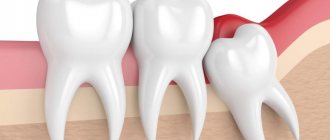Wisdom teeth or “eight” teeth grow in adults. By this age, the jaw is fully formed, there are 28 permanent teeth. Eruption takes about a month and a half, then roots form within 3-4 years. The first period is almost always accompanied by painful sensations and inflammatory processes. During root formation, discomfort rarely occurs. In the case of pathological eruption, inflammation and pain may continue for a long time. Whether discomfort is an indication for removal of the “eight” will be determined by the doctor during a diagnostic examination.
Teeth and inflamed lymph nodes: what is the relationship? Symptoms of pathology, causes, treatment methods
When inflammation of the lymph nodes occurs after tooth extraction, not everyone is ready for such a turn of events. People who have not gone through the extraction procedure (removal) are even less likely to expect an inflammatory process in this important system for the body. However, this phenomenon is not uncommon. At the same time, doctors often find a connection in it with teeth. Let's look at the nuances of this difficult topic together.
Why does the inflammatory process occur?
As you know, the lymphatic system is a very important component of our body. It prevents various pathogens from entering the blood and internal organs, but it itself is often the first to take the blow due to decreased immunity. Many people know that swollen lymph nodes are often the first signal that a person has some kind of disease in the body. They usually swell shortly before the first symptoms of the disease appear. Their increase may indicate a sore throat, HIV, syphilis, tonsillitis, lupus, measles, scarlet fever, arthritis and many other pathologies.
This is interesting! Scientists have found that in the human body there are more than 400 lymph nodes (they are located in small groups) and about 2 liters of lymph that passes through them. The greatest concentration is on the neck and head, under the jaw and chin, under the arms and in the groin. Each group is responsible for the well-being and protection of nearby organs.
However, not everyone knows that inflammation in this important system for the body often occurs due to dental pathologies. This means that the infection gets there from a nearby area, in this case, from the oral cavity, where a large number of different bacteria live. Naturally, staphylococci, streptococci and other harmful as well as beneficial bacteria are constantly present in the mouth, and this is normal. But the problem arises only if microbes multiply rapidly and pathogenic microflora begins to predominate. Why is this happening? Read on.
Prevention
To strengthen the immune system, it is recommended to consume citrus fruits
Each person can prevent the re-development of cervical lymphadenitis due to dental diseases if he follows simple tips:
- In case of lesions in the oral cavity, rinsing with saline solution is required.
- It is necessary to include ginger tea in your diet.
- You should carefully monitor your oral hygiene.
Experts recommend consuming citrus fruits, natural products and honey more often. They help strengthen the immune system and improve the functioning of the lymph nodes.
Main dental problems leading to pathology
- abundant accumulation of bacterial plaque on and under the gums,
- gingivitis and periodontitis,
- advanced caries, pulpitis, periodontitis,
- purulent-inflammatory processes: flux, fistula, abscess, festering cyst and granuloma, osteomyelitis, phlegmon,
- damage to the oral mucosa by stomatitis, especially in acute and recurrent [1] varieties caused by the herpes virus or Candida fungus,
- glossitis of the tongue,
- poorly installed, old fillings and crowns under which inflammation has developed,
- long-term lack of sanitation of the oral cavity: during the sanitation process, the doctor applies a set of measures aimed at eliminating all dental pathologies.
This is interesting! The submandibular lymph nodes are responsible for the condition of the nose, throat, teeth and ears. If they are the ones that become inflamed, then you need to look for pathology in the listed organs, and to eliminate the problem, contact a dentist (in 60% of cases, dental pathologies are detected) or an ENT doctor.
Why does wisdom tooth hurt?
Wisdom teeth almost always grow crooked. Problems with teething are dictated by the following anatomical features:
- “Eights” appear later than all other teeth. As a rule, the jaw bones are fully formed, the dentition is stable, and the “newbie” simply does not have enough space;
- The third molars do not have milk “predecessors”, and the rudiments of wisdom teeth developed for too long and not in very favorable conditions. Because of this, they erupt chaotically, damaging the adjacent tooth or causing inflammation of the gums.
When talking about the causes of pain associated with one or more molars, it is worth distinguishing between some concepts. Toothache can occur against the background of abnormal eruption, due to deformations of soft tissues of neighboring teeth. This clinical picture is typical only for “eights”; other teeth are cut much more smoothly.
Causes
However, the cause of toothache may also lie in fairly classic causes associated with common dental pathologies: caries, periodontal disease or periodontitis. If you systematize all the reasons that cause tooth pain, you will get the following list:
- The wisdom tooth rests too much on the tissues of the oral cavity, squeezing and injuring them;
- The tooth is rotated around its axis. The greater the angle of rotation, the more tense the dental nerve is, which provokes pain;
- Carious cavities have formed on the surface of the wisdom teeth; if they reach the dental tissues, the pain will intensify;
- Tartar deposits have formed, which rub the gums and cause inflammation;
- Due to the fact that the rapid growth of the “eight” and crooked eruption damaged the root system of the neighboring molar, it is this neighboring tooth that hurts;
- If the wisdom tooth, due to its incorrect position, begins to pinch the jaw nerve, pain occurs in the lower jaw. In this case, neuritis manifests itself in this way;
- A follicular cyst has formed at the neck of the tooth. It often occurs against the background of permanent damage to the gum tissue and the tooth itself.
It is worth noting the fact that a follicular cyst near wisdom teeth is often accompanied by all sorts of complications. For example, an abscess may occur that can even deform the jaw in a neglected state. The periodontal tissues may also become inflamed and pericoronitis may develop.
Inflammatory processes of the tissue covering the wisdom tooth
Inflammation of the hood is a common phenomenon. If a wisdom tooth erupts through several crown cusps at once, phenomena may occur when the chewing surface of the crown is partially covered by tissue. The part of the gum and mucous membrane that overhangs the molar and is called the hood. He is constantly susceptible to injury and prone to inflammation.
Under the surface of the hood, particularly favorable conditions arise for the accumulation of various biological “garbage” and the proliferation of pathogenic bacteria. Often even the slightest damage causes irritation. The gums around the “eight” may not hurt much, so they don’t always turn to people with such a problem.
However, if the inflammatory process is severe, the tissues not only swell, but are also irritated. The patient complains of painful swallowing, sometimes it is difficult even to simply open his mouth. There may be pus and severe hyperemia on the gum near the wisdom tooth. Only a doctor can save you from such an obsessive and severe dental inflammation by excision of the hood.
Lack of space during teething
If there is not enough space for the wisdom tooth in the dentition, neighboring tissues are injured during eruption. The pain is total. It hurts not only the place where the molar erupts, but also the neighboring teeth. Swelling, hyperemia, and severe pain that are permanent may also be observed. It is difficult for the patient to open his mouth, especially if the “eights” grow in the direction opposite to the jaw. Such teeth must be removed. This is due to the fact that a crooked tooth can damage the entire dentition, up to its noticeable curvature.
Caries
If a wisdom tooth is affected by caries, the first symptom indicating the disease will be pathological increased sensitivity of the teeth. They will react painfully to any irritants - sour, spicy, salty foods, sweets, cold irritants.
Situations often occur when the curvature of a wisdom tooth injures the neighboring tooth, which causes caries in it. The most dangerous situation is when the “eight” damages the root of the neighboring “seven”. Caries develops just below the gum, and the doctor is not always able to visually identify the carious lesion. At the same time, a severely advanced form of “root” caries is difficult to treat and the tooth can almost never be saved.
Pulpitis
In acute pulpitis that affects the wisdom tooth, patients complain of acute pain that occurs in attacks. The disease and its main manifestations are characterized by a spontaneous nature. Unpleasant sensations can occur spontaneously and last up to 15 - 30 minutes. At night the pain intensifies.
In the chronic form of wisdom tooth pulpitis, the pain is not so pronounced. Unpleasant, aching sensations occur against the background of exposure to cold or heat. If the irritant is removed, the pain continues for some time.
Periodontitis
Periodontitis is characterized by aching pain that constantly worries the patient. At the same time, the diseased tooth will react to any irritant with acute pulsating, shooting pain. Slight mobility of the affected tooth is also noted, and swelling and soreness of the gums are often observed.
It is interesting that with chronic periodontitis the pain is almost not disturbing. Very minor unpleasant sensations can only appear when the “figure eight” is tapped on the patient’s tissues.
Teething and enlarged lymph nodes
The problem is typical mainly for children whose first milk units are being cut. Babies have a weak immune system, and during this period it weakens even more, since the body is under a serious load. Often, teething itself is very difficult, accompanied by alarming symptoms (moodiness, cough, fever, runny nose) and even the addition of bacterial and viral infections.
This pathology does not always escape adults. For example, when a wisdom tooth is cut and the submandibular lymph node increases in size, this is a fairly common occurrence. The third molars pass through the jawbone, and this process takes a long time, plus it is often associated with disturbances. “Sages” can compress and touch the branches of the trigeminal nerve, rest against neighboring elements of the row and destroy them. Their eruption may be accompanied by a decrease in immunity and an increase in body temperature, to which all the defense systems of our body react very sensitively.
Sometimes growth pathologies of the “eights” lead to the development of a purulent-inflammatory process such as pericoronitis. The problem arises when a kind of hood forms between the gum and the not fully erupted “figure eight”, where bacteria and food debris get trapped.
On a note! If your wisdom tooth hurts and the lymph node is swollen, then the symptoms may indicate damage to the third molar by caries, pulpitis, or periodontitis. If the cheek is also swollen, then, most likely, gumboil has developed.
Why does the problem occur after tooth extraction?
Let us list the main reasons why nodes become swollen after tooth extraction.
1. The body's reaction to surgery
It is not uncommon for a lymph node in the neck or under the jaw to slightly increase in size immediately after tooth extraction. Some experts believe that after surgery such a reaction is quite natural, because the body has activated all its forces in order to quickly cope with the physiological trauma inflicted on it.
If you have removed a wisdom tooth and then felt an enlarged lymph node in your neck, then you should not panic ahead of time. Procedures for extracting “eights” are always complex, large-scale and quite traumatic. Therefore, after them, a non-infectious inflammatory process almost always occurs, accompanied by a number of characteristic symptoms: increased body temperature, pain, limited jaw mobility and the inability to open the mouth wide, general weakness.
The procedure was carried out against the background of a purulent-inflammatory process
Typically, patients come for extraction (removal) if there are advanced dental diseases in the mouth that cannot be restored. Often the operation is performed urgently, against the background of an acute inflammatory process. Therefore, enlarged lymph nodes after tooth extraction with periodontitis, gumboil, fistula, cyst, granuloma are a common story. After all, the inflammatory process in this case had already been going on for some time. And it does not go away immediately after eliminating the problematic element; you still have to fight it by taking antibiotics and other medications, lotions, antiseptic rinses, and physiotherapy.
Extraction complications occurred
If several days have passed after tooth extraction, and you notice that the lymph node under the jaw hurts and is inflamed, this may indicate the development of the following complications of extraction:
- alveolitis: this is where it all begins. This is an inflammation of the socket that occurs due to a medical error or due to a violation of the postoperative regimen on the part of the patient. Actually, the complications that we will list below appear because the patient develops alveolitis, or tries to cure the disease on his own and does not seek medical help,
- flux, abscess, phlegmon, osteomyelitis.
Dental diseases and lymph nodes
The submandibular form of lymphadenitis develops when an inflammatory process appears in the area of the teeth, often due to the removal of wisdom teeth
A wisdom tooth, like any other tooth subject to a pathological process, can negatively affect the lymph node. If a person does not treat the problem, he can expect to develop cervical lymphadenitis. This diagnosis means inflammation of the lymph node located in the neck.
Any dental problems can cause the development of lymphadenitis. Because of it, it becomes painful for a person to touch the affected area. If the lymph node is inflamed, it means that the person has started the disease. If you do not start urgent treatment, he will be overtaken by a number of health-threatening complications.
Causes
Complaints that a tooth hurts and at the same time an inflamed lymph node are the result of damage to the inflammatory process of the oral cavity. These symptoms are difficult to ignore, as they are highly severe.
Typically, lymphadenitis is a secondary sign of inflammation. It accompanies the complicated course of dental diseases. Therefore, there is no point in trying to cope specifically with the affected lymph node. First of all, it is necessary to fight the cause of its inflammation.
Due to diseases of the teeth and gums, suppuration begins. Its appearance is usually caused by the entry of pathogenic pathogens into the oral cavity. It is with them that the lymphatic system has to fight. Neighboring nodes take the brunt of the attack. If they do not cope with their task, then they also succumb to the inflammatory process.
Lymphadenitis can develop in an adult or child for the following reasons:
- Herpetic stomatitis.
- Caries, due to which pathogenic bacteria affect the lymph nodes.
- Inflammation of the gums.
- Cysts in the oral cavity.
- A wisdom tooth is erupting (the main reason why the lymph node is inflamed).
- Fungal infection of the oral mucosa.
- Incorrect formation of molars.
- Parasitic pathologies.
- Infectious and bacterial diseases of teeth and gums.
Most often, the problem occurs due to an inflamed tooth that has not been removed. Dentists usually encounter this pathology. Also, inflammation often develops after the removal of a wisdom tooth or any other tooth.
In most cases, inflammation of the lymph nodes indicates the development of the following dental disorders in a person:
- Gingivitis of the gums. It affects the condition of the lymph node. This disease means that a person has inflammation in the oral cavity, in particular the gums. Its development can be caused by the accumulation of a large amount of plaque or the development of pathogenic microflora in the mouth.
- Periodontal disease. This is the name for deep damage to the tissues that are located around the tooth. Its development is caused by improper oral care or its complete absence.
- Caries. The disease is characterized by the gradual destruction of the tooth shell. Like periodontal disease, it is caused by improper oral care.
If the cervical lymph node has enlarged precisely because of a dental disease, then after its elimination the state of formation of the lymphatic system returns to normal.
Symptoms
At the first sign of discomfort in the mouth, you should immediately contact your dentist
Inflamed teeth and gums cause an enlarged lymph node in the neck. The painful condition is characterized by a number of symptoms that force a person to seek medical help. The following signs allow you to suspect the development of a dental problem and inflammation of the node:
- General malaise.
- Chills.
- High body temperature.
- Pain when opening the mouth.
- Edema and swelling at the location of the lymph node.
- Pain when palpating the node and swallowing.
All these symptoms create severe discomfort that prevents a person from performing everyday activities. Therefore, if the lymph node and tooth hurt, you should immediately consult a doctor.
Complications after tooth extraction
Enlarged lymph nodes are not the only complication that can occur in a person some time after the removal of a problematic tooth.
Complications worry patients who, for medical reasons, were forced to get rid of their wisdom teeth.
A child and an adult may experience complications (pain occurs, the node becomes inflamed) after an operation to remove teeth that are inflamed. Most often, patients encounter the following negative consequences due to their own fault or due to a doctor’s error:
- Inflammation of tissue at the site of tooth extraction. Because of it, the patient has bad breath. He is also concerned about pain of moderate severity.
- Nerve damage. The pathology worries patients whose nerve endings were affected in the surgical area.
- Alveolitis of the socket. One of the most serious complications, which is accompanied by inflamed lymph nodes. This can cause gum damage. Pathology develops due to the removal of any teeth.
- Osteomyelitis of the jaw. This is the name of a purulent process that is accompanied by inflammation of bone tissue. It is caused by infectious agents that enter the oral cavity.
Because of the wisdom tooth and others, the formation in the neck area, which is included in the lymphatic system, increases in size and hurts. If treatment for lymphadenitis is not started, it will lead to even more serious complications. Among them are:
- Phlegmon. Due to pathology, the lymph nodes become enlarged. They may enlarge due to severe swelling. The pathological process actively spreads to all tissues of the neck. The node can rapidly increase in size, and the skin acquires a bluish tint. Due to phlegmon, it is difficult for a person to move the mouth.
- Inflammatory process in neighboring tissues. The active proliferation of pathogenic bacteria leads to the progression of the infection and its spread to neighboring areas. Without treatment, the disease causes tissue breakdown.
- Degeneration into a tumor. Any dentist can confirm that lymphadenitis is quite capable of leading to the development of a tumor-like neoplasm. It appears from conglomerates that tend to merge with each other.
Every person should know that the nodes of the lymphatic system can become inflamed if a wisdom tooth grows or the gums are infected. Therefore, at the first symptoms of illness, you should immediately consult a doctor. This is the only opportunity to prevent the development of complicated conditions.
Signs of pathology
If there is no pathology and the person is healthy, then the lymph nodes are quite difficult to palpate. But if there are problems in the body, their condition changes. At first, the inflamed areas only swell slightly and increase in size, which becomes noticeable upon palpation. The pathology is not accompanied by any other signs at the initial stages.
If, due to dental problems or after tooth extraction, the lymph node hurts, then it means that the person has started the underlying disease, against which he may have developed lymphadenitis. What is this? This is just inflammation of the lymph nodes. Let us list the symptoms of the pathology.
- Swelling and enlargement of the areas under the jaw, chin and neck. When you feel them, you can find lumps and even lumps. In rare cases, the lymph node behind the ear may also increase in size, for example, if there are eruption pathologies or complications arise after the removal of a wisdom tooth.
- Discomfort when opening the mouth, chewing and swallowing food, when swallowing saliva and drinking liquids (soups, drinks). Pain when pressing on inflamed and enlarged areas. In later stages of the disease, pain can spread to the neck, head, and radiate to the jaw and throat.
- Increased body temperature. The more the disease progresses, the higher the temperature. The thermometer can reach 40°C.
- The appearance of general malaise and weakness, chills, insomnia.
Diagnostic search
Table 1: Diagnostic measures to identify the causes of pain in the gum and lymph node:
| Purpose of diagnosis | Ways to achieve |
| Patient Interview | Collecting anamnesis of life, illness, clarification of complaints, symptoms of diseases, how long ago symptoms appeared and the characteristics of their manifestation, determining the presence of concomitant diseases |
| Oral examination | Determining the presence of diseases of the gums, mucous membranes, teeth |
| Lymph node examination | Inspection, palpation, determination of the location and mobility of the lymph node |
| General facial examination | Determining the presence of other inflammatory processes |
| Examination of the nasal cavity and nasopharynx | Determining the presence of diseases of the respiratory system |
| Definition of infectious agent | Determine what is causing an enlarged lymph node |
| Consultations with other specialists if necessary | ENT specialist, dentist, ophthalmologist, infectious disease specialist, oncologist. |
Differential diagnosis
Attention, to make a correct diagnosis and treatment, consultation with a doctor is necessary. Only a doctor can conduct differential diagnosis, clinical and additional examinations, establish connections between diseases and prescribe treatment. Pain and inflammation in the lymph node is a secondary and easier to diagnose disease.
To determine gum disease, it is necessary to carry out a differential diagnosis of possible diseases:
| Name of the disease | Definition | Accompanied by enlarged lymph nodes | Symptoms | Treatment |
| Gingivitis | Gum inflammation | In acute form, with herpetic and aphthous lesions | Pain, swelling, redness, swelling, increased gum size | Local, etiotropic, anti-inflammatory |
| Periodontitis | Inflammation of the tooth ligament | In good shape | Pain, swelling, redness, swelling, exudate from the gums | Professional oral hygiene, anti-inflammatory therapy of gum tissue |
| Periodontal disease | Dystrophic damage to the tissues around the tooth | Rarely | Pain, discomfort, itching in the gums | General and local effects on gum tissue. |
| Periodontitis | Inflammation of the tissue behind the apex of the periodontal tooth | Rarely, in acute inflammation | Pain when biting on a tooth, pain and redness of the gums | Removal of the tooth nerve and medicinal treatment of the inflammation site. |
| Periostitis | Inflammation of the periosteum and gums | Yes | Sharp pain in the alveolar process, gums, swelling, facial asymmetry, increased temperature | Removal or treatment of a tooth, incision of the gum and periosteum. Local and general drug treatment. |
| Pericoronitis | Inflammation of the gums above or near the wisdom tooth | In purulent form | Pain in the gums and jaw in the area of the last teeth, swelling and redness of the gums | Tooth extraction or excision of the gum above the tooth, drug therapy. |
| Stomatitis | Inflammation of the mucous membrane of various etiologies | In acute form, with herpetic and aphthous lesions | The presence of lesions on the mucous membrane, gums, and tongue. Painful sensations. | Professional oral hygiene, local and general treatment with medications. |
Pain in the gums and pain in the lymph node brings discomfort
Dangerous consequences of pathology
If you do not promptly treat the underlying problem that caused the swelling and enlargement of the lymph node, then, as mentioned above, you will develop lymphadenitis.
Usually, the submandibular form of the disease occurs first, but in the absence of therapeutic measures, the infection descends lower, and then the cervical type of pathology develops. That is, the lymph nodes in the neck become inflamed, which poses a serious threat to life and health. For those who do not consult a doctor on time, the body may become severely intoxicated.
From the acute form, the disease passes into the chronic stage, and pus begins to accumulate in the tissues. When the pathology is neglected, there is a risk of developing phlegmon [2], thrombosis, the formation of malignant tumors, as well as a purulent abscess, the contents of which can at any time break into nearby organs, spread through the hematopoietic system, reach the bronchi and respiratory tract, and cause sepsis.
Inflammation of the lymph node
Inflammation of the lymph node can cause neck pain
The lymphatic system and nodes belong to the body's immune defense system. The nodes are a kind of filter for infection and a sensor that shows the presence of inflammation.
Lymph nodes enlarge and hurt when performing their function - retaining microbes, infections, foreign cells.
Inflammation of the lymph nodes occurs:
- Due to other diseases (most common).
- An independent disease (in the absence of diseases of other organs, lymphoma, metastases).
According to the nature of inflammation, lymphadenitis occurs:
- Serous. Symptoms will be enlarged, painful lymph node. Treatment will include searching for the underlying cause and conservative therapy.
- Purulent. It is characterized by an enlarged lymph node, severe pain, redness of the skin, increased temperature, and a disturbance in the general condition. Surgical and medical treatment is necessary.
Professional diagnostic measures
When a lymph node becomes inflamed, you should not hesitate to see a doctor. It is better to start by visiting a dentist, who will examine the oral cavity and send you for an x-ray to obtain information about the presence or absence of hidden processes and dental pathologies.
Additionally, the patient may need the help of other specialists: an ENT doctor, a therapist, an infectious disease specialist. Be prepared that for a detailed diagnosis you may be referred for urine and blood tests (usually they reveal an increased number of leukocytes), bacterial culture, and ultrasound.
Treatment
If a person has a toothache or is starting to erupt, he will be disturbed by an enlargement of the nearby lymph node. When teething, the development of cervical lymphadenitis is not excluded, which should not be left to chance.
Therapy for an inflamed tooth, gum and lymph node includes taking medications. Only the doctor decides what means to treat the disease. He will also tell you what procedures to carry out after treatment in order to consolidate the result achieved with its help.
The following therapeutic measures can contribute to recovery:
- Sanitation of the oral cavity.
- Rinse with Burov's solution.
- Opening abscesses if present.
- Antibacterial therapy.
- Vitamin therapy.
- UHF.
A surgeon may be needed if the patient needs to have swollen lymph nodes cleaned.
Measures to eliminate the problem
Dental treatment
In order for the lymph nodes to return to normal, it is first necessary to get rid of the main problem that caused their enlargement and inflammation. Depending on the pathology, the dentist can perform the following manipulations:
- cleaning teeth from plaque and tartar,
- treatment and filling of root canals,
- surgical opening and drainage of ulcers (with flux, abscess),
- cleaning the socket (for alveolitis),
- tooth-preserving operations: cystectomy and cystotomy, resection of the root apex for cysts and granulomas,
- replacement of unsuitable fillings and crowns.
After treatment of dental pathologies, the lymph nodes do not disappear immediately. Swelling may persist for the next 7-10 days. In order for the patient’s condition to normalize faster, he is additionally prescribed physiotherapy (for example, UHF therapy) and prescribed medicinal support.
“I once had a tooth removed with periodontitis on the lower jaw. A few days after this, I noticed that the lymph node was a little swollen and painful. I didn’t want to go to the dentist again, I hoped that it would go away on its own. Then the hole healed safely, but the swelling under the jaw sometimes appeared again. In general, I started this case, and when more frightening symptoms appeared, I ran to the doctors. I was told that there was pus inside the lymph nodes and it needed to be cut out. There was no choice, I had surgery, then took antibiotics. Now I regret that I didn’t go to the clinic right away...”
S. Tsareva, review from gidpozubam.ru
Drug therapy
The doctor will prescribe medications to take at home. In case of inflammation of the lymph nodes, as well as in advanced dental diseases, a course of antibiotic therapy is prescribed for 7-10 days. The patient is also recommended ointments for applying external lotions and applications to the affected areas. Additionally, immunostimulants and multivitamin preparations are prescribed, which must include vitamin C to boost immunity.
Symptomatic treatment is also prescribed. For fever, antipyretics are taken, and for pain, painkillers are taken.










